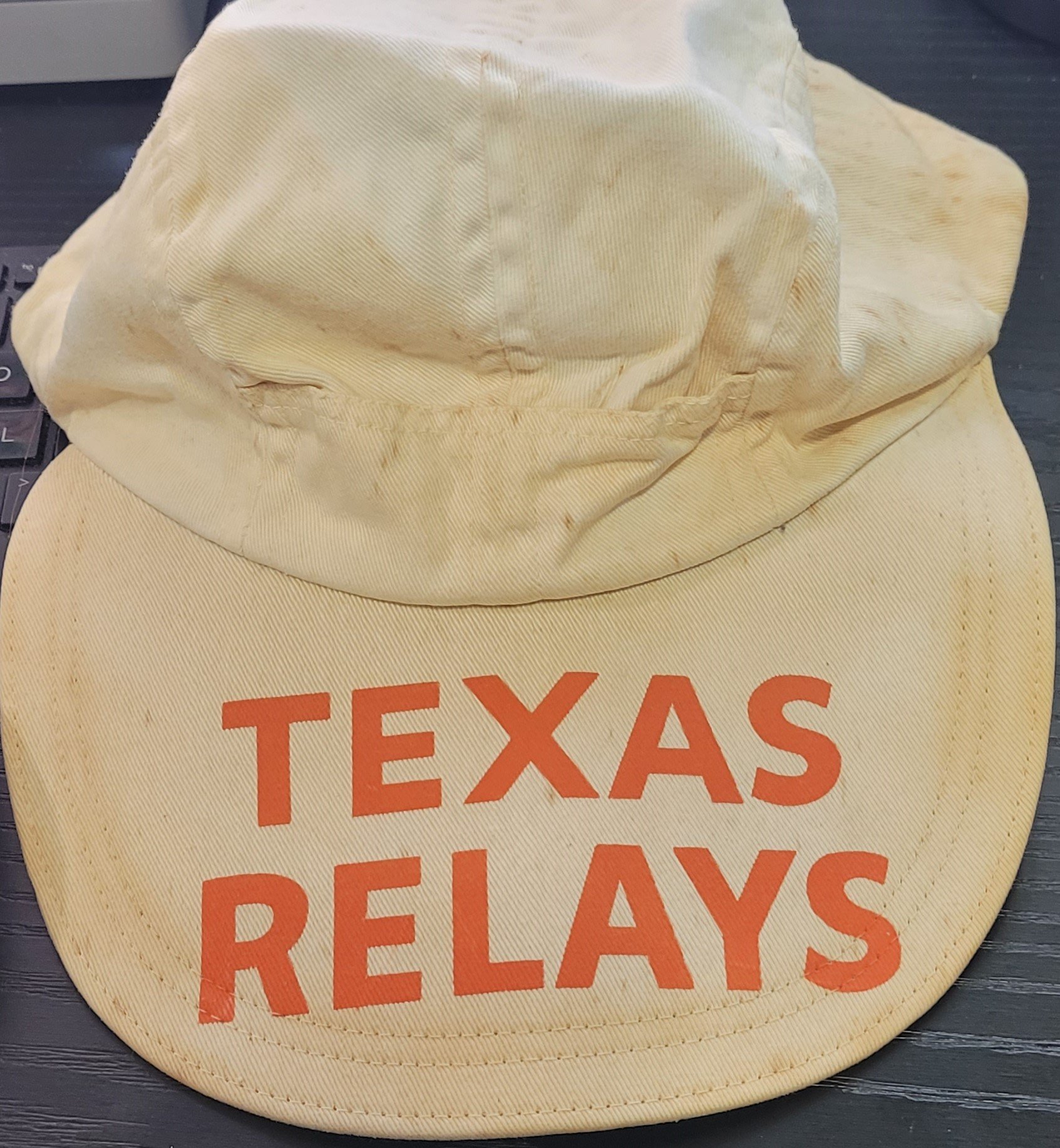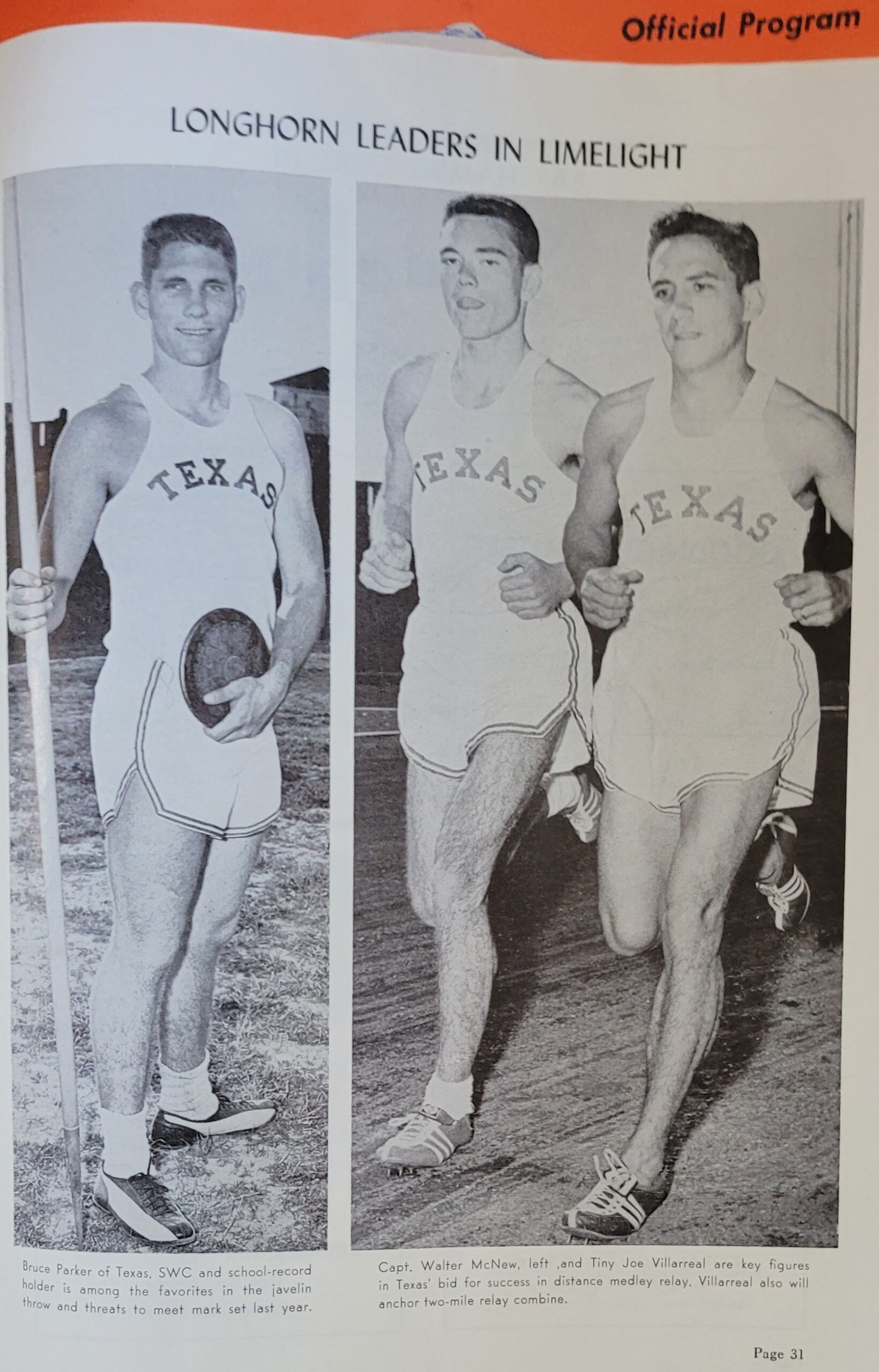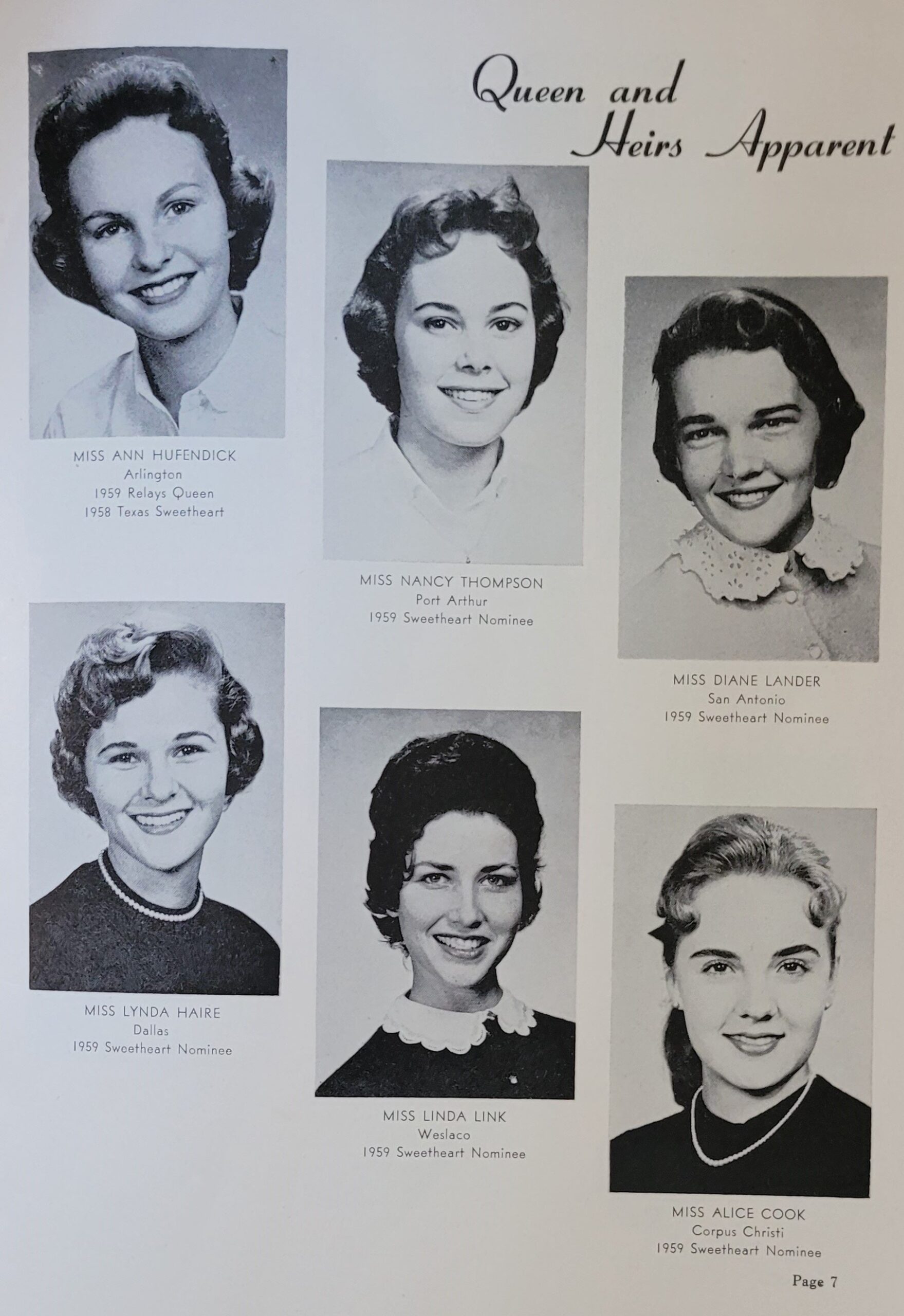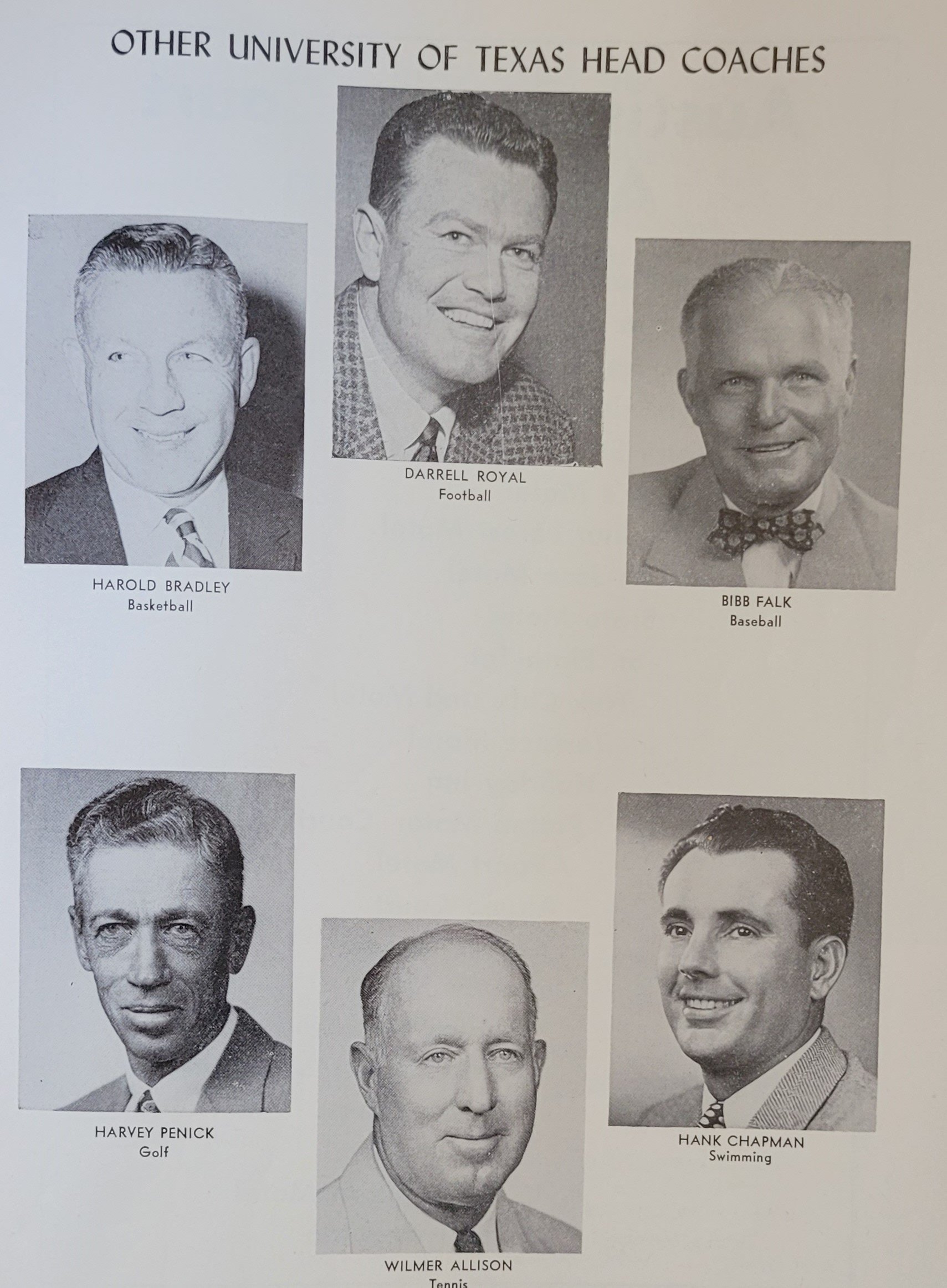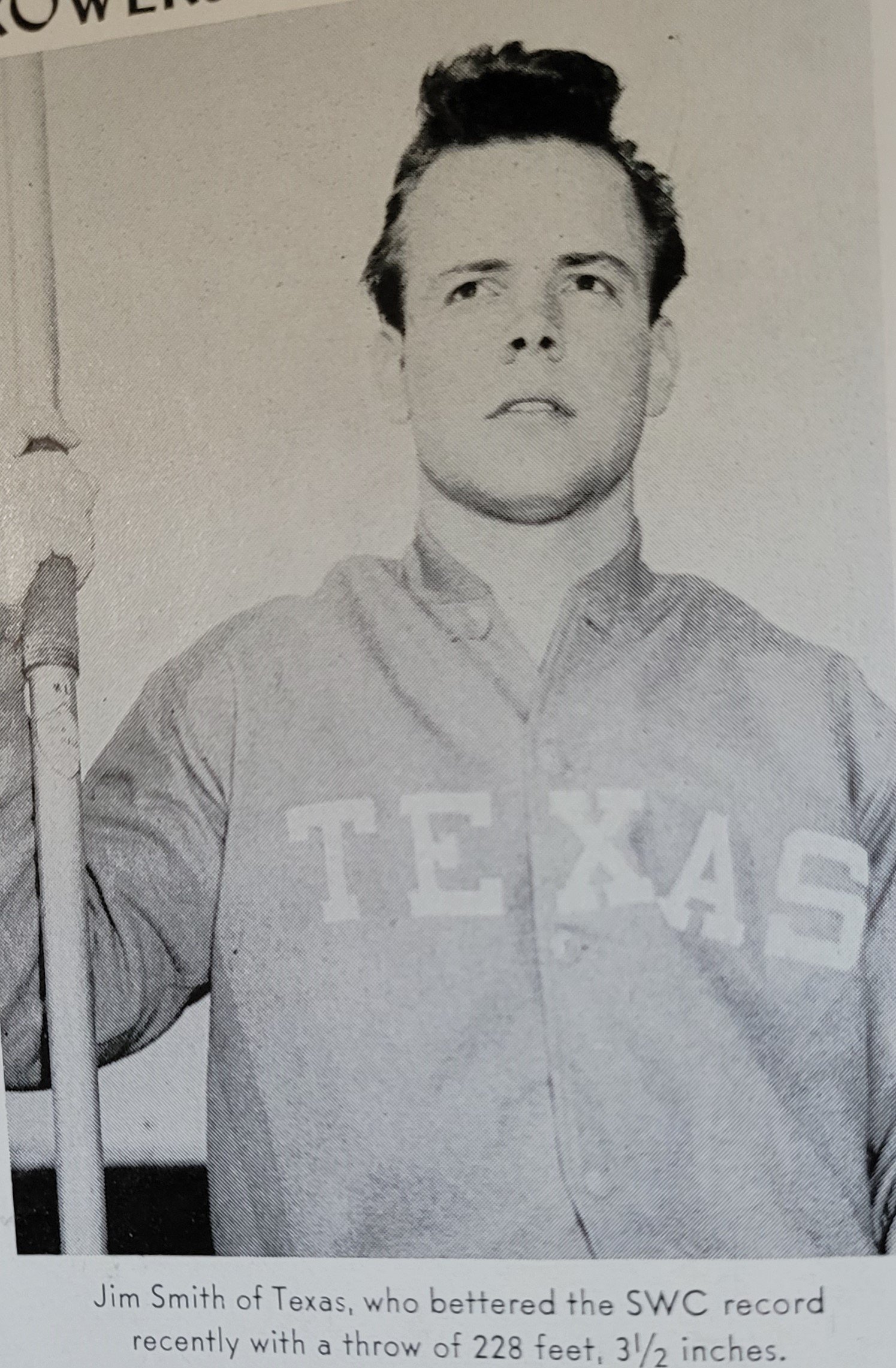Texas Relays
On this day in 1925, Longhorn track coach Clyde Littlefield inaugurated the Texas Relays at the Texas Memorial Stadium, drawing to Austin some of the best college track athletes and even three Olympians. The stadium, now the Darrell K Royal-Texas Memorial Stadium, has been the home of the University of Texas football and track teams since 1924. In that year Henry Jacob Lutcher Stark, chairman of the UT Board of Regents, and L. Theo Bellmont, athletic director, led a fundraising drive to erect the stadium on the eastern edge of campus. An estimated 10,000 students, alumni, and friends of the university gave money to build the 27,000-seat facility, which was designed by architect Herbert M. Greene of Dallas. The stadium was dedicated to Texans who had served in World War I. The stadium has been renovated and greatly expanded a number of times over the years.
Texas Relays in Austin since 1925
3/27/1925: Clyde Littlefield and Theo Bellmont inaugurated Texas Relays at Memorial Stadium. On this day in 1925, Austin, some of the best college track athletes, and even three Olympians. The stadium, now the Darrell K Royal-Texas Memorial Stadium, has been the home of the University of Texas football and track teams since 1924. In that year, Henry Jacob Lutcher Stark, chairman of the UT Board of Regents, and L. Theo Bellmont, athletic director, led a fundraising drive to erect the stadium on the eastern edge of campus. An estimated 10,000 students, alumni, and friends of the university gave money to build the 27,000-seat facility, which was designed by architect Herbert M. Greene of Dallas. The stadium was dedicated to Texans who had served in World War I. The stadium has been renovated and greatly expanded a number of times over the years.
This historical competition is among the most popular track and field events in the U.S.
Texas Relays is the second biggest track and field event in America after Penn Relays featuring about 900 teams and over 7,000 athletes every year. The event is held every March or April at Mike A. Myers Stadium in Austin, Texas. For many years, the event has been organized by The University of Texas. The competition features elite college athletes, potential Olympians and best high school talents from all over the state. The competition is watched by over 50,000 spectators.
Women started competing in the Texas Relays in 1969. In 1999, the Relays moved to Mike A. Myers Stadium. The Relays generate 8 million dollars for Austin businesses and communities. The competition consists of The University and College Divisions, which are open to schools that qualify. The High School Division is open to schools in the University Interscholastic League classes A, AA, AAA, and AAAA.
Below is part of a Bill Little commentary that takes “dead aim.”
03.25.2014 | Bill Little Commentary
Bill Little commentary: Chasing the dream, racing the wind
What would they think, those legends and legions of men and women who race the wind?
Bill Little, Texas Media Relations
Bill Little, a longtime sports publicist at The University of Texas, first covered the Texas Relays as a student journalist for The Daily Texan in 1962. He has attended almost every meet since.
What would they think, those legends and legions of men and women who race the wind?
Here we are, in a sparkling facility with a state-of-the-art competitive arena, in the midst of new era in track and field in Texas. Across the street, continued upgrades are envisioned to a 90- year-old venue that has seen history and its moments. Gone forever is the track where super stars past and present ran.
But as one who knew Clyde Littlefield, Jack Patterson, and Cleburne Price, I believe I can speak to what they would think.
They would be bursting with pride because, once again, Texas has created the best.
Memories, hanging like portraits on the chambers of the mind, will always be there…………
The list of honorary referees included University greats and almost every Texas governor, from Dan Moody in 1929 to Price Daniel in 1958.
The huge shadow of Clyde Littlefield, perhaps the greatest athlete in Texas history, was cast on this meet in the 41 years he served as Texas Track and Field coach. Gentleman Jack Patterson brought a quiet class to the Relays.
The late Cleburne Price took the meet into the modern era. He made the weekend a happening with a Texas Relays Art Show and other events built around a track meet, which grew to mammoth proportions with over 3,000 athletes.
The list of great performers and their performances reflect a legacy that is forever cast in those photographs in our minds.
But the Texas Relays have been about more than just a computer-generated result with a picture to determine the finish. They have been about people.
It has been about Longhorn legends such as the late Rooster Andrews, who first worked the Relays as a student in 1941 and served until the first decade of the 21st century, and all of the officials and administrators who have donated their time.
The Relays have been about times—not only the times on the scoreboard but also the times in which we lived.
Women first participated in the meet in 1963. In the early 1960s, when integration was progressing slowly in the state’s major colleges, the flying feet of the Texas Southern Tigers dominated the meet. One of my earliest memories of almost 40 years of covering the Relays was Ray “Jackrabbit” Saddler, who was a superb quarter miler for TSU……..
The 70s brought a strong influence, particularly in the distance races, of foreign athletes. The University of Texas at El Paso was particularly powerful.
Price, in an effort to put more “pomp and circumstance” in the meet, set a time for a march of the officials. It was followed by a solemn playing of the Star Spangled Banner. …….
Thousands cheered in 1977 as a Longhorns freshman, Johnny “Lam” Jones posted a world record time in winning the 100-meter dash. The world of track had made the transition from yards to meters, and the old track in the stadium, which had gone from cinder to artificial surface in 1969, was squeezed together and converted to the longer distance of 400 meters, rather than 440 yards.
The Relays have showcased teamwork in a sport known for individual excellence. The baton races, the heart of the meet, have thrilled people year after year. Progress has brought not only superior performances by male athletes, but also the women’s and high school competition to an all-time high level. Olympian Sanya Richards-Ross is a perfect example of the level of female excellence.
While there have been world record performances in the field events, this is, and always will be, a meet that is about running. Field events bring outstanding performances. Running events, particularly if Texas is winning, bring the crowds……..
Texas relay cap in the 1960’s
Some men dream and some men do, and Mike Myers is a doer. His generosity, and his commitment to UT Athletics are reflected in a gift that will live for all time. And it is not coincidental that this excellent facility is part of the legacy of former UT Men’s Athletics Director DeLoss Dodds, who brought great Kansas State track teams to Austin and the Relays. He would never forget his roots when it came to building the best for that sport…..
The Texas Relays weekend has evolved into a multi-cultural event in Austin, and its power as a statement for diversity has brought a whole new impact on Austin and the rites of spring. Reunions, parties, and gatherings help celebrate events that draw as many folks to the city as the track and field carnival itself.
Part of Bill Little’s article celebrating the history of the Texas Relays



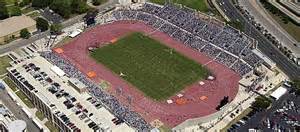
So when the question is asked, who are the ten best athletes in Longhorn Sports’ history, why is no individual who specializes in track not listed? I don’t have the answer, but I can make an educated guess why and that guess is not flattering to the Longhorn Nation.
Track is rooted deeply in my past and is still my favorite sport because of lessons learned while participating. Track forces individuals to confront personal character flaws, demons, personal weaknesses, and insecurities. Jesse Owens Says about mental toughness “The Battles That Count Aren’t the Ones For Gold Medals. The Struggles Within Yourself – The Invisible, Inevitable Battles Inside All Of Us – That’s Where It Is At.” Patti Sue Plumer agrees, saying, “Racing teaches us to challenge ourselves. It teaches us to push beyond where we thought we could go. It helps us to find out what we are made of. This is what we do. This is what it’s all about.”
I have experienced the invisible struggles that have exposed my flaws, challenged my soul, and uncovered my insecurities. In my senior year in high school, I set my personal best time in the 100 but finished Last in my heat. As a 17-year-old boy, I was surprised when I was happy finishing last, but this epiphany helped me re-calibrate my definition of success for my life journey. It is ok to celebrate finishing last if it is your personal best.
The first Texas Relays is March 27, 1925.
3/27/1925: Littlefield inaugurates Texas Relays at Memorial Stadium
Preparing for the Texas Relays
Clyde was part of Longhorn sports as a student-athlete and football and track coach from 1912- 1961. Clyde is in the Texas Sports Hall of Fame, Longhorn Hall of Honor and twice was named SWC Coach of the Year. As an athlete, Coach Littlefield earned 12 letters in football, basketball, and track. He was All SWC in football twice and played on three unbeaten basketball teams, but track was his truest love. He never ran on a losing track team, and he Lost only one hurdles race in his career and tied a world record in the high hurdles.
Littlefield with Theo Bellmont analyzed the state of track in the 1920s and saw an opening for another track meet. All the major midwest track tournaments were further North, and the athletes had to train indoors until April. Littlefield thought “WHY NOT INVITE TOP ATHLETES, down to Austin ahead of the relay tournaments up North and give them a touch of warm sunshine early in their training season. The timing was right because the new Texas football stadium opened in 1924.
Theo Bellmont- a consummate promoter- by the sheer power of his will makes the first Texas relay a massive success with 391 athletes and 4000 fans. The Austin American said it is the “greatest athletic event ever held in the Southwest.” Three members of the 1924 United States Olympic team participated in the Texas Relays.
Competition in the “College” level was added in 1926.
Jim Reese from Texas wins the mile. This portends great things in the future for Jim.
College division of track and field was added in 1926. First victories in the college division were from Longhorn J.J. Landa in the 100, Rugus Haggard in the high jump, and Sandi Esquivel in the 2-mile run.
1927
Illinois, Michigan State, Iowa State, and Missouri attended the relays. Texas won very few medals. The relays had four classifications: university, college, jr. college, and high school. There was also some competition for well-known athletes for superior exhibition performance.
But these teams were overshadowed at the Texas relays by “The University of Mexico and the men Tarahumara Indians, who ran from San Antonio to the Texas stadium (89 Miles). Shortly before 3:00 A.M., three men worked their way from San Antonio to Austin without the help of an interstate road. At 6:12 P.M., the women entered Memoria stadium- 14 hours and 53 minutes after leaving San Antonio. It was the longest race ever time.
The women Tarahumara Indians followed the men. At a time in America, when it was believed that women’s “delicate” bodies could not withstand the stresses of athletic endeavors, The Tarahumara women proved otherwise. A 14-year-old mother ran 28 and 5/8 miles to Georgetown and back to Memorial Stadium in 4 hours and 49 minutes.
10,000 spectators celebrated the accomplishments of these young men and women. For the only time in Texas Relay history, college and Olympian track athletes honored and celebrated another culture’s sports accomplishment. It was literally, Cross Country distance running at its finest.
Lola Cuzarare wins
1927
In 1927 Notre Dame, Iowa State, and Michigan State attend the Texas Relays. 13 Texas Relay records were broken. Austin was now on the “National” map.
1931
March 27th, 1931 more than 1000 athletes from 16 states competed. The Texas relays were essential to the middle of the country – Kansas, Iowa State, Minnesota, Chicago, Marquette, Oklahoma, Drake, Nebraska, and Northwestern.
1932-1935
Due to the depression from 1932 – 1935, the Texas Relays was canceled.
1932 the Longhorn accountants asked for a curtain call on the Texas relays due to the depression. The Texas relays were suspended for three years.
1935 Clyde Littlefield and business manager Ed Olle 8000 fans attend the games.
1940
The Texas Relays hits a zenith in 1940, outperforming both the Penn and Drake relay tournaments. Unfortunately, fan interest in track and field started to wane, and only 5000 fans attended to watch the fastest sprint medley relay, the longest discus throw, the highest pole vault, and the fastest shuttle hurdle relay up to that time.
1941
Mac Umstattd, Fred Ramsdell, Bill Seay, and Morris Barefield.
On April 5, 1941, the Texas Relays was as crucial as the Drake and Kansas relays. The Longhorn 1941 team was one of the best winning the Texas Relays, SWC, and celebrating two All Americans.
Texas set one world record and finished first in 5 events. Carlton Terry won the 100, and Fred Ramsdell was second. Jack Hughes won the triple crown in the Javelin throw. Barefield, Seay, Umstattd, and Ramsdell won several relays. The Texas relays times exceeded 10 of 15 events at the Drake and Kansas relays.
1944
1944- Because of the war effort, the 17th Texas relays team attendance was way down. Most of the competition came from the air force, naval air stations, and army installations. Ralph Ellsworth won the 100 and anchored the victorious 440 and 880 relay teams.
1947
1947- Longhorns win 5 of 8 relays this year, setting two Texas relay records. Perry Samuels, Parker, Charley Tatom, and Allen Lawler led the relay way for the Horns.
From 1925-1976 the big-name national and international stars are the draws that attract fans.
1948
5 Olympians compete at the Texas Relays preparing for the London Olympics.
1951
6 Olympians compete at the Texas Relays.
1956
For the first time, the Texas Relays is a two day event. The competitors included four national collegiate champions and five performers destined for the Olympics. The Horns dedicated the meet to the 1941 4X100 relay team of Seay, Ramsdell, Terry, and Hill and the 1941 spring medley team of Barefield, Seay, Ramsdell, and Umstattd. Both of these relay teams set the national collegiate record. The Horns win the 4 x 100 in a time of 40.8. It is the 16th time in 22 years that Horns won this event at the Texas relays.
1957
1957 – ten Texas relay records are broken, two equaled with the Horns setting new standards in the 880 relay and mile relay. Eddie Southern won the hurdles, Pat McGuire the broad jump.
1958
In 1958 California and Stanford participate in the Texas Relays for the first time. Southern, Brook, Patrick, Drew Dunlap, and Jimmy Holt set a new Texas relay record in the mile relay.


1959
1959 Texas Relays

1960
43 schools from across the nation and two from Mexico participated in the Texas relays.

1961
34th Annual Texas Relays
For the first time since 1930, the Texas track team failed to win a single event. Jim Allison was second in the shot put and javelin. Ralph had a bad day.
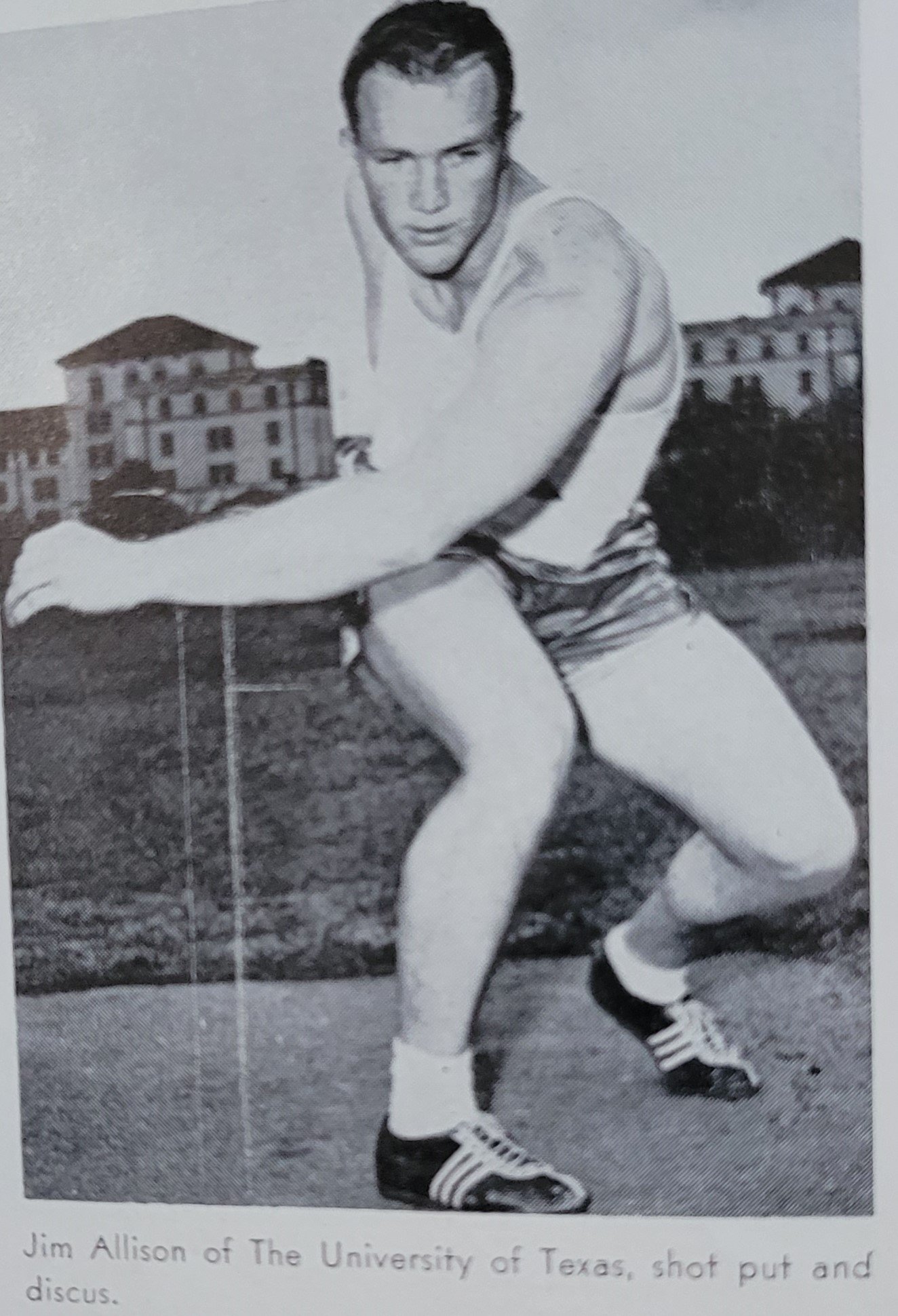


Relays were expanded to 44 events. One of the new events was the steeplechase.
1962
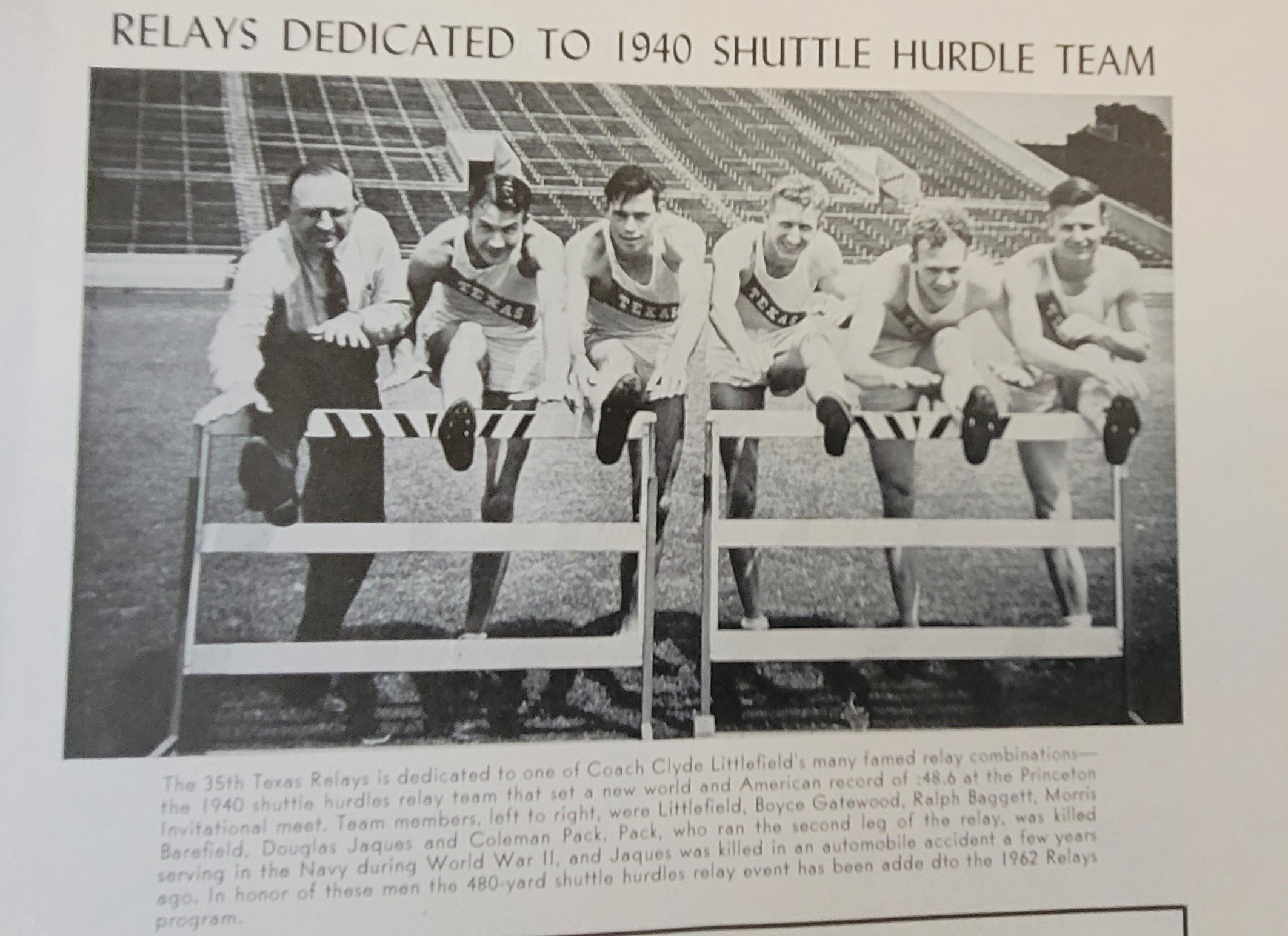
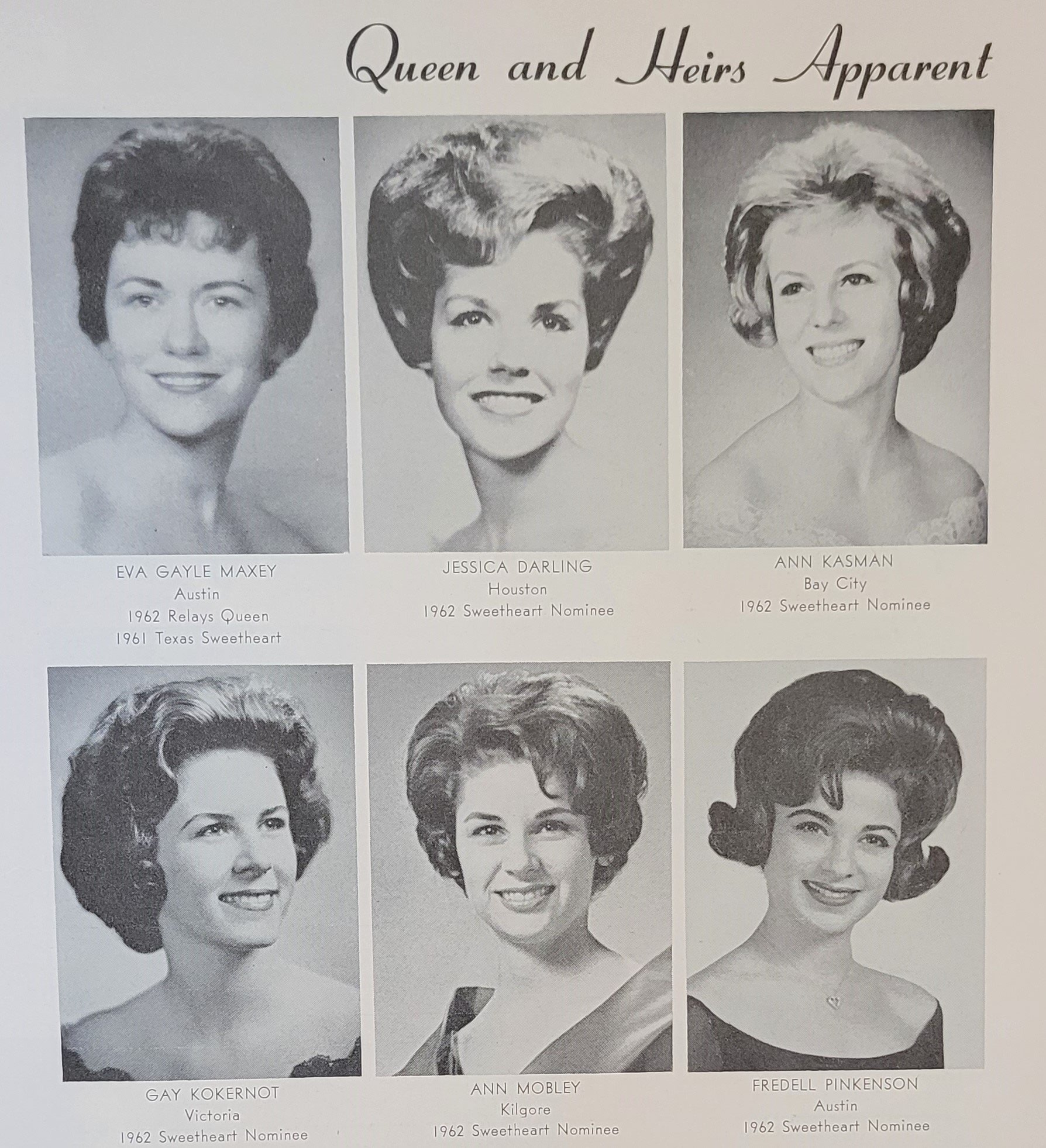

12,000 watch Ray Cunningham win the 120 hurdles
1963




In 1963 women events are added to the Texas Relays.
1968
Dave Morton MVP 1968
photos compliments of Rey Moreno
When UT Track was in the football stadium, the shot put ring was on the northwest corner of the field. The crowd was about 10 yards from the shot area- separated by a 4-foot wall. Being close, you could see and feel the size of these giants. You could hear grunts during their throw. You were amazed at their quickness as they would come out of their spin. You could see the determination on their face.
To see a 16-pound steel ball fly through the air is amazing!
1970 Texas Relays
This was one of the best Texas Relays ever. 100 teams including 11 women and 1300 athletes set many Relay records. The Aggies dominated the University division. Horns did not win one event.
1975 Golden Anniversary years
1925 there were 391 participants in the Texas Relays. In 1975 2,840 participate in the Texas Relays.
1975 Jimmy Strong runs his leg of the 4 x 800 relay
In 1976 with the conversion to metric-measurement, many new records are set.
A Texas Relays clock was presented to All four Relay winners.
Rey Moreno says “First place winners received a Texas Relays watch during Cleburne Price coaching period ( sorry no picture). In 1975 the watch was a gold digital Texas Instrumentals watch. Watches were presented @ all major Relays, including Kansas and Drake.
1977 Texas Relays
In 1977 this changes. Cleburne Price feels it is no longer necessary to promote “billboard” names to attract fans. Open Events will continue to be part of the Texas Relays, but Collegiate competition is the future for the Texas Relays. Price feels that competition in the college and University ranks is good enough to draw fans. The “college format” will be the future of the Texas Relays. He was right.
Photos compliments of Rey Moreno
U.T. Administrators
1978- photos compliments of Rey Moreno
1979 Texas Relays photos compliments of Rey Moreno
1980 Texas Relays
1981-1983 Texas Relays
Teams from UCLA, Florida, Florida State, Kansas, Minnesota, and many more attended the Relays. Approximately 2000 athletes representing 200 schools competed.
1983
In 1983 the Texas Relays awards its first women’s heptathlon championship.
1984
1984 Glen Swenson Texas Relay program
1990
1990 Texas was named the outstanding team at the Texas Relays. It was their first such honor since 1973.
The Longhorn 4 x 400 wins the Texas Relays for the first time in 15 years. Keith Keller finishes second in the decathlete at the Texas Relays.
2008-2009
Horns had three first-place finishes and five runner-ups, with two individuals having personal bests: Maston Wallace in the pole vault and Brandon Drenon in the shot put. Drenon won the discus in the Penn relays.
Maton Wallace and Brandon Drenon
Destinee Hooker won the 5th Texas Relay crown. Alexandria Anderson had a personal best in the 100 meter- the fastest time for a college runner during the season. Horns Anderson, Cooper, Stewart, and Smith had the second fastest time in the 4 x 400 in the country.
2010
Betzy Jimenez won the 1500-meter title. Longhorn broke records and outperformed their expectations.
Angele Cooper won the 400 hurdles in 56.52, which was the fastest time in the nation this year.
Trevante Rhodes
takes the hand off at the Texas Relays.
2011 Texas Relays
Stacy=Ann Smith
2013 Texas Relays
A & M is the most outstanding team. Horns place first in the 1600 relay
2014
2013-2014- 86th Texas relays – Ryan Trouser wins the shot put with the best toss in the nation. Danielle Dowie wins the 400- meter hurdles in the nation’s fastest time. Patrick McGregor, Trevor Van Ackeren, Zack Bilderback, and Kyle Thompson won the men’s distance medley relay. . Courtney Okola, Kiersten Duncan, Chalonda Goodman, and Christy Udowin the 4 x 200 relay. Texas men Kyle Merber, Trevor Van Ackeren, Kyle Thompson, and Patrick McGregor win the 4 x 800. Jarard Bruner wins the men’s triple jump.
